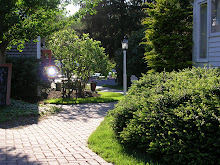Below are a few of the beautiful patterns designed by Emma Bridgewater. The designer's products have long been adored for their color and style!










DESIGN: The Basics
When the decorated space is broken down into its most basic components, the general elements that emerge are pattern, color, and shape. If those parts are examined more closely, with even greater precision and a more expert eye, additional distinctions can be made, and the categories can be described in further detail.
To illustrate this concept, we can begin by examining PATTERN.
In interior decorating, pattern comes in many forms and from diverse sources. That is, it may be in the fibers of fabrics, the treatment of painting, the surface of objects, or the inclusion of the objects themselves.
Historically, pattern has been used for a variety of purposes. The artful use of pattern enables communication, sets a tone and even serves practical purposes.
Pattern conveys such information origin through its roots in a certain country or culture, social or economic status through its associations or quality, and ritual or convention through its traditions. Often times it is without knowing that we evaluate the pattens used in design and come to conclusions about the space. Below are just a few examples of this notion at work along with very brief explanations of the theory in action. These were also chosen because they are amongst our favorite products and designs!
In interior decorating, pattern comes in many forms and from diverse sources. That is, it may be in the fibers of fabrics, the treatment of painting, the surface of objects, or the inclusion of the objects themselves.
Historically, pattern has been used for a variety of purposes. The artful use of pattern enables communication, sets a tone and even serves practical purposes.
Pattern conveys such information origin through its roots in a certain country or culture, social or economic status through its associations or quality, and ritual or convention through its traditions. Often times it is without knowing that we evaluate the pattens used in design and come to conclusions about the space. Below are just a few examples of this notion at work along with very brief explanations of the theory in action. These were also chosen because they are amongst our favorite products and designs!
This is the tartan of the University of St. Andrews, Scotland, from the Scottish Register of Tartans. It is an example of the way in which pattern work to evoke images of distinctive places or cultures.

This is a traditional French country toile pattern used on a Pierre Deux wallpaper. Again, it illustrates the evocative power of pattern when used in decoration.
In the above photographs, the first of a wedding scape at the Caneel Bay Resort and the second a vintage Jaguar, the crisp whites suggest the marriage rite. Although neither are indoor spaces, both use a traditional design to conger images of weddings.
Pattern not only communicates factual information, but also emotional. In many cases pattern can be used to enliven a space, to create a certain mood, or to inspire decisive action. Below, again, are just a couple of examples of this in practice.

The Academy Awards Architectural Digest Green Room at the Kodak Theater designed by Roger Thomas. Perhaps one of the best examples of pattern hard at work. Here, it becomes evident that a masterful combination of simple surfaces and smooth textures can very effectively elicit a feeling of serenity and warmth in viewers. In this case, the calming effect is not only pleasurable but also necessary!
Finally, pattern may be used to disguise both wear and tear and poor quality. This practical function is often used in family or public spaces. It may be seen, for instance, in ornate motifs or rugged textures.

The upholstery in this Brunschwig & Fils print advert exemplifies the type of print that would successfully disguise an average amount of wear and tear. Deep colors and a bold pattern help to make it a suitable choice in heavily lived in rooms.

This interior from www.standout-fireplace-designs.com, featuring a "cowboy country stone fireplace", serves as an example of one way in which pattern appears through textured surfaces. The rustic, rugged features of this design help to disguise imperfections resulting from age and heavy use.When designers employ patterns, they do so deliberately and they commonly depend on trial and error to produce the intended effect. With a skilled eye and a keen working knowledge of each of the above concepts, they exploit pattern both aesthetically, to convey a certain message, and for practical purposes, appropriate for their intended use.

The Academy Awards Architectural Digest Green Room at the Kodak Theater designed by Roger Thomas. Perhaps one of the best examples of pattern hard at work. Here, it becomes evident that a masterful combination of simple surfaces and smooth textures can very effectively elicit a feeling of serenity and warmth in viewers. In this case, the calming effect is not only pleasurable but also necessary!
Finally, pattern may be used to disguise both wear and tear and poor quality. This practical function is often used in family or public spaces. It may be seen, for instance, in ornate motifs or rugged textures.

The upholstery in this Brunschwig & Fils print advert exemplifies the type of print that would successfully disguise an average amount of wear and tear. Deep colors and a bold pattern help to make it a suitable choice in heavily lived in rooms.

This interior from www.standout-fireplace-designs.com, featuring a "cowboy country stone fireplace", serves as an example of one way in which pattern appears through textured surfaces. The rustic, rugged features of this design help to disguise imperfections resulting from age and heavy use.




No comments:
Post a Comment